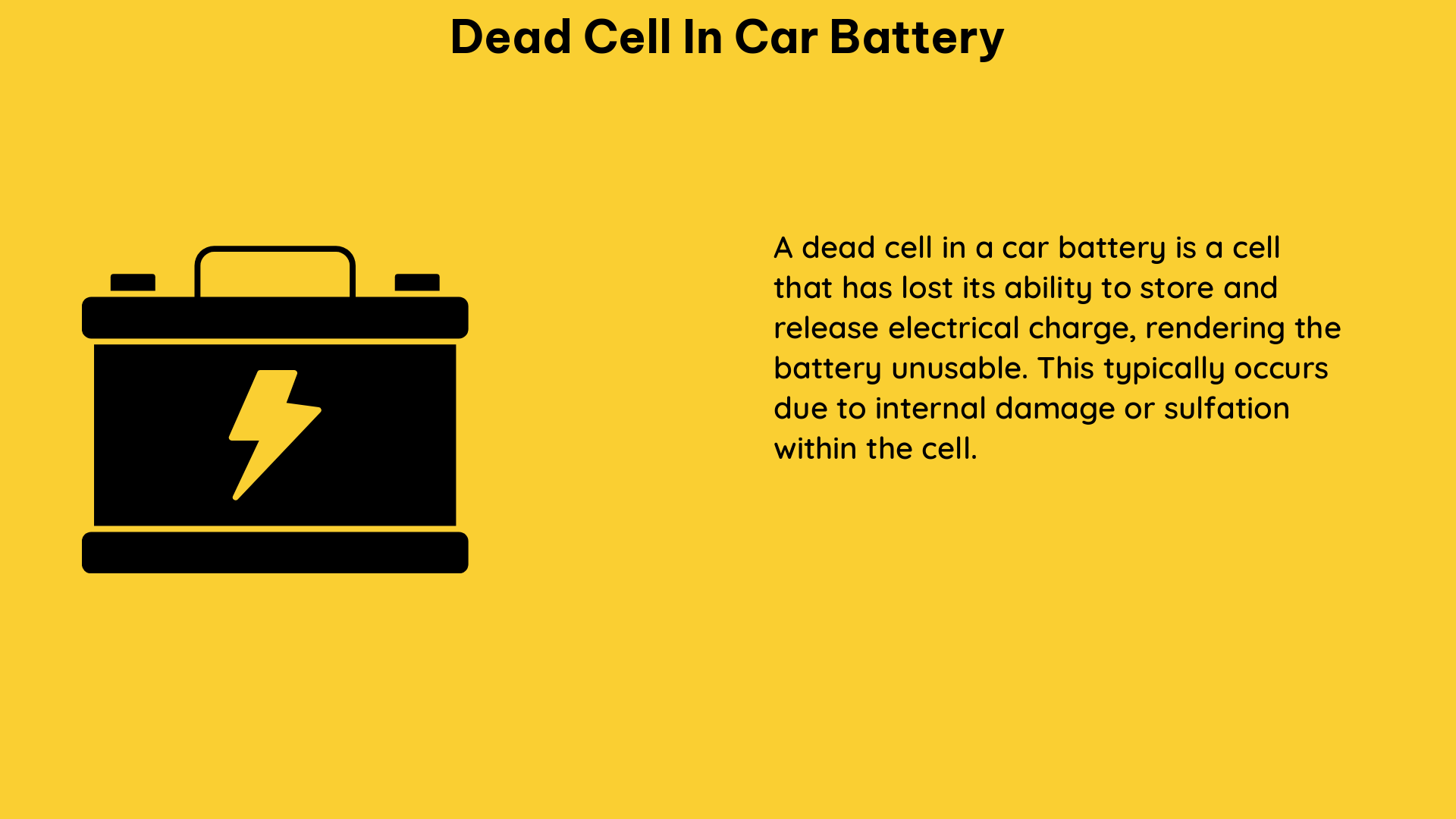A dead cell in a car battery refers to a cell within the battery that can no longer hold a charge or function properly. This issue can significantly impact the overall performance and lifespan of your vehicle’s power source, potentially leading to starting problems, reduced battery life, and even the need for a complete battery replacement.
Understanding the Causes of a Dead Cell
There are several factors that can contribute to the development of a dead cell in a car battery:
-
Plate Damage: The lead-acid plates inside the battery can become damaged over time due to various factors, such as overcharging, deep discharging, or physical impact. This damage can prevent the cell from effectively storing and releasing energy.
-
Sulfation: When a battery is left in a discharged state for an extended period, lead sulfate crystals can form on the plates, reducing the battery’s capacity and leading to a dead cell.
-
Separator Failure: The separators that isolate the positive and negative plates within each cell can degrade or become compromised, causing an internal short circuit and a dead cell.
-
Electrolyte Imbalance: Improper maintenance or the addition of incorrect electrolyte can lead to an imbalance in the battery’s acid-to-water ratio, which can contribute to the failure of individual cells.
-
Overheating: Exposure to high temperatures, either during operation or storage, can accelerate the degradation of the battery’s internal components, increasing the risk of a dead cell.
Identifying a Dead Cell

There are several methods you can use to detect a dead cell in your car battery:
Open-Circuit Voltage Test
- Measure the open-circuit voltage of the battery, which is the voltage when the battery is not under load.
- A healthy 12-volt battery should have an open-circuit voltage between 12.6 and 12.8 volts.
- If a single cell is dead or internally shorted, the open-circuit voltage may be lower, as the other cells in the battery will be overcharging to compensate.
Load Test
- Perform a load test on the battery to assess its ability to maintain voltage under a specific load.
- A load tester applies a controlled load to the battery and measures the voltage drop.
- A battery with a dead cell will typically show a more significant voltage drop under load compared to a healthy battery.
Specific Gravity Test
- Use a hydrometer to measure the specific gravity of the electrolyte in each cell.
- A healthy cell should have a specific gravity between 1.260 and 1.280.
- A cell with a significantly lower specific gravity may indicate a dead cell.
Visual Inspection
- Carefully inspect the battery for any signs of physical damage, such as cracks, leaks, or bulging.
- Look for any discoloration or corrosion on the battery terminals or connections.
- If the battery case appears swollen or deformed, it may indicate a dead cell.
Addressing a Dead Cell
If you have identified a dead cell in your car battery, there are a few options you can consider:
Battery Replacement
- If the battery is beyond repair or the cost of reconditioning is not justified, it may be necessary to replace the entire battery.
- When replacing the battery, ensure that the new one is compatible with your vehicle and has the appropriate capacity and specifications.
Battery Reconditioning
- In some cases, it may be possible to recondition the battery and restore the dead cell.
- Techniques such as equalization charging, the addition of electrolytes, or the use of battery desulfators can help to revive a dead cell.
- However, these methods may not be effective in all cases, and a battery that has suffered significant damage or reached the end of its lifespan may still need to be replaced.
Cell Replacement
- If the battery has a removable cell design, it may be possible to replace the individual dead cell.
- This process requires specialized knowledge and equipment, and it may not be practical for all battery types.
- Replacing a single cell can be a cost-effective solution, but it’s important to ensure that the replacement cell is compatible with the rest of the battery.
Preventive Maintenance
To help prevent the development of a dead cell in your car battery, it’s important to follow proper maintenance practices:
- Regular Battery Checks: Periodically check the battery’s voltage, specific gravity, and overall condition to identify any issues early on.
- Proper Charging: Ensure that the battery is charged correctly, avoiding overcharging or deep discharging, which can contribute to sulfation and plate damage.
- Cleaning and Maintenance: Keep the battery terminals and connections clean and free of corrosion, and check the electrolyte levels regularly.
- Temperature Control: Avoid exposing the battery to extreme temperatures, either during operation or storage, as this can accelerate the degradation of the internal components.
- Timely Replacement: Replace the battery when it reaches the end of its lifespan, typically every 3-5 years, to prevent the development of a dead cell.
By understanding the causes, detection methods, and proper maintenance practices for a dead cell in a car battery, you can proactively address this issue and ensure the reliable performance of your vehicle’s power source.
References:
– What is a dead battery cell, what causes this to happen, and what are the implications?
– How to tell if a battery’s got a dead cell
– Bring your dead batteries back to life

The lambdageeks.com Core SME Team is a group of experienced subject matter experts from diverse scientific and technical fields including Physics, Chemistry, Technology,Electronics & Electrical Engineering, Automotive, Mechanical Engineering. Our team collaborates to create high-quality, well-researched articles on a wide range of science and technology topics for the lambdageeks.com website.
All Our Senior SME are having more than 7 Years of experience in the respective fields . They are either Working Industry Professionals or assocaited With different Universities. Refer Our Authors Page to get to know About our Core SMEs.